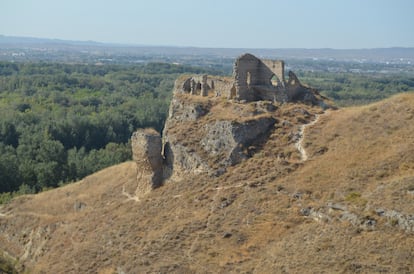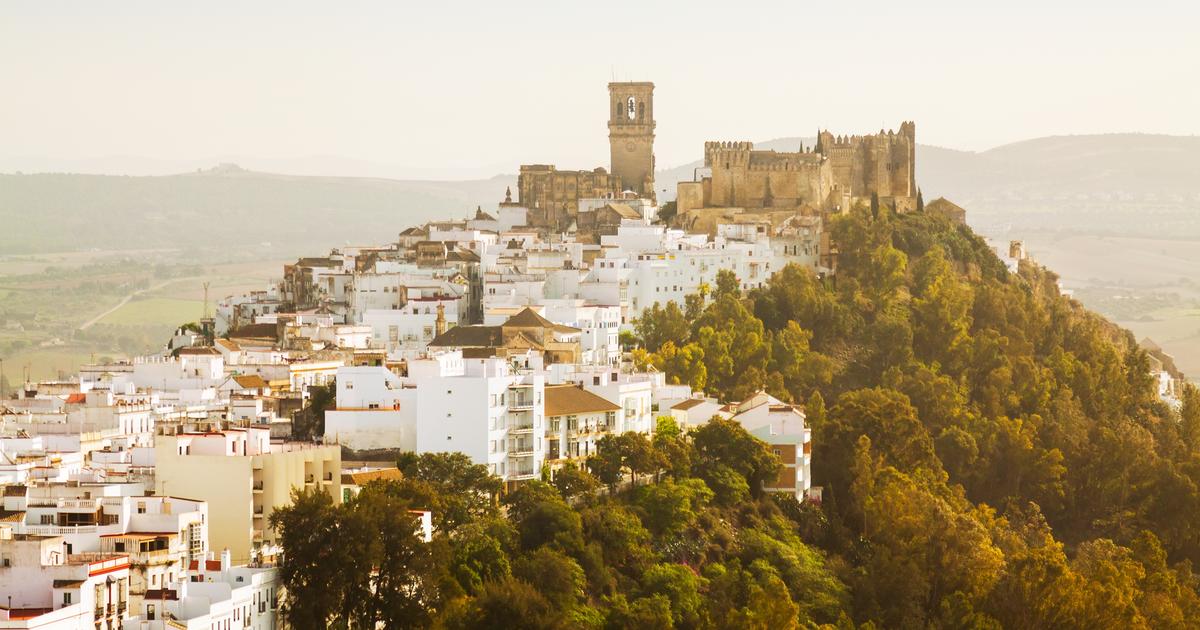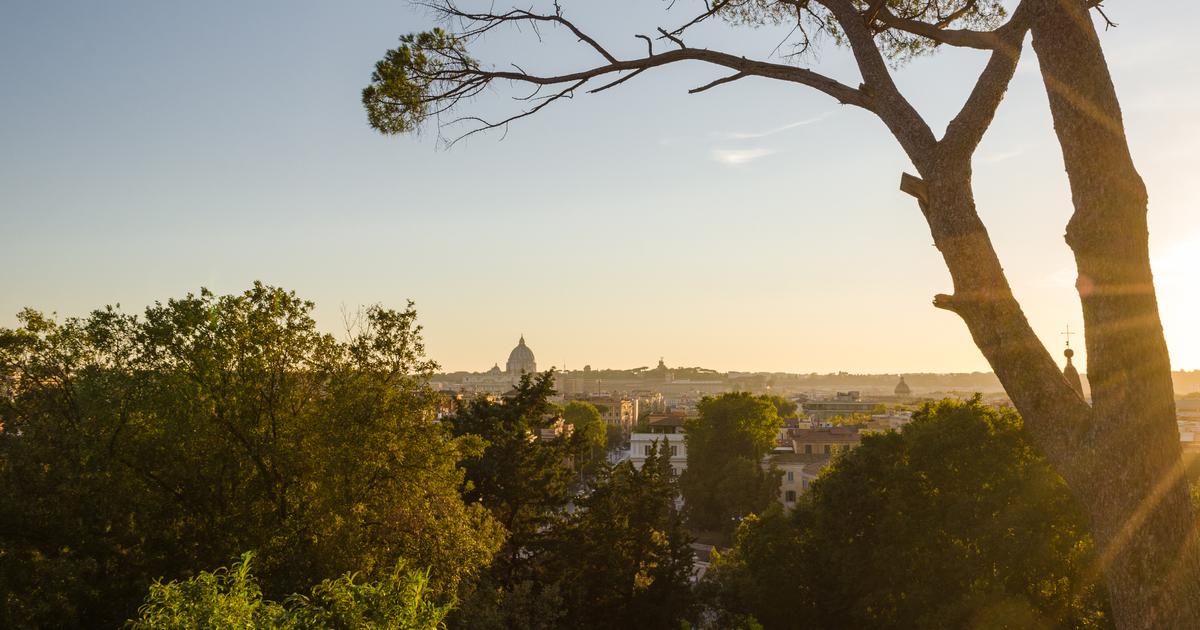Large mihrab base built with masonry and Alabaster plaster ashlars, in the country town of al-Jazeera.
The enclave is in the head of Miranda (Zaragoza) .José Ángel Asensio Esteban
Before raising the lavish palatine city of Medina Azahara, Abderramán III (891-961), the caliph who made Córdoba the capital of the new Muslim empire of the West in the 10th century, founded four other ephemeral cities from which he made himself strong to put an end to the rebellious families who dared to challenge the might of the Umayyad dynasty. Enclaves in which he resided with his court, which had a fortress, mosque and souk and served as an essay for Medina Azahara, the most beautiful example of Caliphate-style architecture in al-Andalus. The archaeologists José Ángel Asensio and Virgilio Martínez Enamorado have discovered the exact location of one of them: al-Jazeera (the Island), where the caliph settled to defeat the rebels in Zaragoza.
From al-Jazeera, in one of his great war adventures, Abderramán III besieged the Tuyibíes of Saraqusta (Zaragoza) for four years, who dominated the Ebro valley and wanted to free themselves from Cordoba authority. Two Muslim chroniclers relate the events and date them between 934 and 937, but no one until now had located this camp city built by the caliph who called himself "He who makes the religion of Allah triumph." Asensio and Martínez Enamorado have discovered that al-Yazira was in the head of Miranda, an enclave on the banks of the Ebro in the municipality of Zaragoza and seven kilometers in a straight line from the basilica of Pilar.
The head of Miranda, seen from the north, with the ruins of the 12th century castle raised on part of the remains of the caliphal camp city of al-Jazeera. In the background, the city of Zaragoza.José Ángel Asensio Esteban
Researchers have identified the stone foundations of the mosque, the remains of its mud brick walls and mantles of Arab tiles of more than half a meter that have the typical stratigraphy of the collapse of a large building that would occur after the abandonment from the camp. Also, plant remains from other buildings. “I had studied the mosque in the 1990s. Then the remains of the plant with its three ships were more visible, but he had not linked them to al-Jazeera. It is a large building with a capacity for about 350 people, very similar to other mosques that were built in Córdoba at the same time, such as the Fontanar or the Caliphate that is in the Santa Clara convent. There are also remains of a wall four meters wide that would close the part of the head that faces the mountain,because what overlooks the valley is a cliff about 50 meters high that does not need defense. According to the chroniclers, there was a fortress and on the plain were the soldiers' camp and a souk, ”says Asensio.
Archaeologists have carried out their study during the pandemic and have published the result, entitled
At the gates of Zaragoza
, on May 31 at the Cadiz publishing house La Serranía.
Through the almost 300 pages of this work, which includes the original Arabic texts and their translations, revised by Martínez Enamorado, the authors have followed a hypothetical deductive process and have verified that "everything works together like the machinery of a clock", in words of José Ángel Asensio (Zaragoza, 52 years old), doctor in History and specialist in Roman and Andalusian architecture.
In 2003, the scholar published that most of the remains that were discovered in the head of Miranda in the 1973 excavation campaign led by Guillermo Fatás, which were then dated as Iberian-Roman, are actually from the 10th century.
What had been described as a Roman basilica is the floor plan of a 180-square-meter mosque with three naves and a mihrab facing southeast, a typical al-Andalus orientation, similar to that of Medina Azahara. However, in his research published in 2003 in the magazine of the University of Zaragoza
Saldvie
, Asensio presented the discovery as a rural mosque and did not relate it to the country town of Abderramán III.
Virgilio Martínez Enamorado (Casabermeja, Málaga, 56 years old), doctor in Medieval History, Arabist and professor at the University of Málaga, had previously located and published the location of two other of the four camp cities founded by the Umayyad Caliph.
He installed them in Malaga to reduce Bobastro's mutineers: Talyayra (in El Castillejo de Álora) and al-Madina (in a farmhouse in Antequera).
The fourth of the enclaves, from which it besieged Toledo from 930 to 932, has yet to be identified.
More information
A farmhouse in Malaga hides a mosque of Abderramán III
“José Ángel read the news of the discovery of al-Madina that appeared on the front page of EL PAÍS on December 25, 2019 and he contacted me to tell me that in 2003 he published an article about a rural mosque very close to Zaragoza. When we checked the references that appear in the Arabic texts and the dates, everything fit perfectly ”, explains Martínez Enamorado.
Ibn Hayyan (Córdoba, 987-1075), the great Umayyad chronicler, mentions the city several times in his book
Muqtabis V:
“The next day the army left its camp at Huerva and went to plant it at al-Jazeera in the Ebro, at the gates of Zaragoza, where the victor of the religion of Allah [Abderramán III] stopped and established his camp with all his troops and recruits, building palaces and buildings for himself, his children and his falls, being able to observe from some of the high points erected by the city of Zaragoza, whose citadel dominated ”.
References also appear in the work of the Al-Udri geographer and historian Al-Udri (1003-1085), who resided for some time in Zaragoza: “In the year 936 the Prince of the Believers set out on a campaign against Zaragoza, staying in the camp for the purpose of to surround the city with a belt.
He gave the order to build the wall in the same camp.
The bridge was conquered and Ibn Hasim's situation became untenable.
So he changed his behavior and sought the path of repentance (…) and Abderramán entered Zaragoza on November 23, 937 ”.
Constructive remains of the mosque of the head of Miranda, discovered in the excavation of 1973, but erroneously attributed to the Iberian-Roman occupation.
Currently, the foundations are covered by weeds.José Ángel Asensio Esteban
To corroborate their hypothesis, Asensio and Martínez Enamorado have also returned to study the material found during the 1973 campaign, which is deposited in the Provincial Museum of Zaragoza: “They are ceramics and stone remains that are cataloged as from Roman times, but a large part They are from the 10th century. They are fragments of common pieces, such as oil lamps and bottles with very prominent necks and a strange decoration in this geographical context, it is not typical of the Ebro valley, but of the south of al-Andalus ”, they explain.
A very busy head
The head of Miranda is currently within the field of maneuvers of San Gregorio of the Army and borders the natural space of the Juslibol galacho, so, although entry is prohibited, it is common for many people to cross the limit and climb the closed. The first occupation of the land on the promontory overlooking the Ebro dates from the Iron Age, from the 6th and 5th centuries BC. Its plateau was later an Iber-Roman settlement and in the 10th century it became al-Jazeera for four years, a very frequent Arabic place name in river environments that also appears as Aliacira or Algeciras.
“Al-Jazeera disappeared from the texts in the 12th century and in the 13th century the area was re-inhabited and the castle of Miranda was built, which was completely abandoned in the 15th. Later, in the ruins, a hermitage was built dedicated to the Virgin of Miranda and which was attended in pilgrimage until the middle of the 19th century ”, Asensio enumerates. After the publication, in which the Government of Aragon has collaborated, the archaeologists trust that an archaeological campaign can be started to study the head of Miranda in the light of the new data.









/cloudfront-eu-central-1.images.arcpublishing.com/prisa/S7ERVSCT4FUVX6R7TUVBDNTH5Y.jpg)



